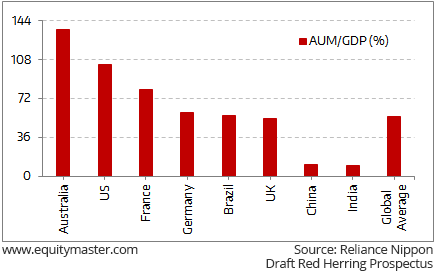- Home
- Todays Market
- Indian Stock Market News November 21, 2017
Sensex Opens Firm; Consumer Durables & Realty Stocks Gain Tue, 21 Nov 09:30 am
Asian stock markets are higher today following the lead from Wall Street overnight amid strong economic data. The Shanghai Composite is up 0.33% while the Hang Seng is up 0.88%. The Nikkei 225 is trading up by 1.02%. US stocks rose on Monday as Wall Street bet tax cuts would keep economic expansion going.
Back home, India share markets have opened the day on a positive note. The BSE Sensex is trading higher by 129 points while the NSE Nifty is trading higher by 34 points. The BSE Mid Cap index and BSE Small Cap index opened the day up by 0.5% & 0.6% respectively.
All sectoral indices have opened the day in green with consumer durables sector and realty sector witnessing maximum buying interest. The rupee is trading at 65.06 to the US$.
As per the latest data with industry body the Association of Mutual Funds in India (AMFI), market participants have pumped over Rs 510 billion into various mutual fund (MF) schemes in October after pulling out more than Rs 160 billion in the preceding month.
With the latest inflow, total infusion in MF schemes reached to over Rs 2.5 trillion in the first seven months (April to October) of the current fiscal.
Reportedly, investors have poured in a net of Rs 511.5 billion in MF schemes last month as compared to a pull out of Rs 166 billion in September. The latest inflow has been mainly driven by contributions from equity, equity linked saving schemes and income funds. Equity and equity linked schemes attracted Rs 160 billion and income funds received Rs 408.5 billion.
Just Released: Multibagger Stocks Guide
(2018 Edition)
In this report, we reveal four proven strategies to picking multibagger stocks.
Well over a million copies of this report have already been claimed over the years.
Go ahead, grab your copy today. It's Free.

Additionally, close to Rs 60 billion was invested in balanced funds. In contrast, gold exchange-traded funds (ETFs) continued to see net outflow of Rs 0.3 billion.
Further, the inflow has also helped in pushing the assets under management of the 42-player mutual fund industry to an all-time high of Rs 21.41 trillion at the end of October from Rs 20.40 trillion in September-end.
One shall note that, the mutual fund industry has grown at an annual rate of 18% in the past decade, and is expected to grow by 20% over the next five years.
However, the share of mutual funds in financial savings remains abysmally low at 2.9%. Currency and deposits, on the other hand, have a lion's share of 40% whereas insurance and pension contribute a quarter each to overall financial savings.
No wonder, India has the lowest mutual fund penetration globally. The total Assets under Management (AUM) to GDP ratio of India stands at a mere 10%, way below the global average of 55%. Countries like Australia and the US have AUM to GDP ratios of over 100%.
India Fares Poorly in Mutual Fund Penetration

So, the mutual fund industry in the country provides huge scope for growth and development. Real estate and gold have become less attractive forms of investments post notebandi. Even the reduction in bank deposit rates in the past year has led to a shift in investment to mutual funds and the stock markets.
Moving on to the news from banking sector. As per an article in a leading financial daily, Union Bank of India has started road shows for its Rs 20 billion qualified institutional placement (QIP).
Reportedly, the public-sector bank will be raising funds in the first week of December.
Further, the funds raised will help the lender to boost its capital adequacy. As on 30 September, the capital adequacy ratio of Union Bank of India stood at 11.22%. The firm posted a loss of Rs 15.3 billion during the second quarter of the current fiscal as against a net profit of Rs 1.2 billion during the corresponding period last fiscal, due to front-loading of provisions.
Moreover, on 6 November, Moody's Investors Service revised credit outlook for Union Bank of India from negative to stable, citing the recapitalization programme announced by the government and improved capital buffer.
This year, QIP fund-raising activity has been dominated by large issuances in the banking and financial services sector. Till September this year, 20 companies had raised Rs 396.8 billion through QIPs.
Speaking of QIP route of equity raising, QIPs tend to be a faster way to raise capital as the dealing happens with a few investors - only institutions in this case. And this is why companies prefer this route - because of its convenience and fewer resource requirements compared to other methods of raising equity.
Notably, during the current fiscal year, State Bank of India raised Rs 150 billion in June through QIP, the biggest so far by any bank. In August, Vijaya Bank raised Rs 7 billion through the QIP route.
Interestingly, QIPs are set to touch a record high in 2017. Buoyancy in the market and positive sentiment towards primary issuances are giving confidence to companies and investment bankers to push ahead with their capital-raising plans.
Union Bank share price opened down by 0.3%.
For information on how to pick stocks that have the potential to deliver big returns, download our special report now!
Read the latest Market Commentary


Equitymaster requests your view! Post a comment on "Sensex Opens Firm; Consumer Durables & Realty Stocks Gain". Click here!
Comments are moderated by Equitymaster, in accordance with the Terms of Use, and may not appear
on this article until they have been reviewed and deemed appropriate for posting.
In the meantime, you may want to share this article with your friends!